Cherokee altered for 2019 as mainstream winner
WESTLAKE VILLAGE, Ca.
When Jeep brought out its all-new Compass redesign a year ago, I thought Jeep might be wise to simply discontinue the Compass, because the stylishly larger Cherokee and the much larger Grand Cherokee covered the larger SUV end of the scale, the Wrangler had the rugged end blanketed, and the new, funky and popular Renegade was closing in from the smaller end.
Shows what I know. The Compass came out for 2018 with a neat, contemporary front end, bypassing the more unique looking Cherokee to become more similar to the larger Grand Cherokee, with its seven-slot grille. While shorter, the Compass also had more interior room than the Cherokee.
That sort of left the Cherokee hanging out to dry. When it was introduced in 2014, the Cherokee was striking in its departure from the signature look of its Jeep siblings, with a more horizontal grille topped by squinty-eyed headlights on the upper edge. My son, Jack, and I agreed it was the best-looking member of the Jeep family.
With every imaginable nook of the SUV and CUV scope seeming to be covered, the Compass was surprising both because it is impressive even if it comes only with a 2.4-liter 4-cylinder engine, and for some reason, Jeep designers allowed it to have more interior room than the larger Cherokee. That’s like giving the little brother weight-training until he’s more capable than big brother.
Ah, but now we learn of Jeep’s long-range plan. With the Compass all new a a 2018 model, the next Cherokee has just been introduced as a 2019 vehicle, and invited auto media got a chance to drive it hard, on highways, bad roads, and off-road terrain a sane person might never consider driving a vehicle. In a word, the bigger and roomier Cherokee regains its rightful slot as being just under the Grand Cherokee, and more capable than the Renegade, Wrangler or Compass, if you count everyday highway driving and family duties as a prime consideration.
The new Cherokee uses the 2.4, which is the only engine in the Compass, but it also gets the impressive 3.2-liter V6 for optimum towing capability. The prize of the litter, in my opinion, is the new-design 2.0-liter 4-cylinder, which is an amazingly potent little powerplant that already is enjoying a strong start to its heritage. It is the same engine used by the all-new Wrangler, which is still the company’s over-achieving all-terrain champ. But in the Cherokee, the 2.0 pushes it to the front of the class, even against the Grand Cherokee for real-world use.
And all the Cherokee had to sacrifice to carve its new niche was its look of uniqueness. I’m sorry to see the squinty-eyed lights go away, and I’m a little disappointed to see Cherokee’s styling leave being unique behind for a return to the family focus of vertical seven-slot grille with nests of LED lights enclosed in a single pod on either side of the new grille.
But I will give it this: No matter how much you like the current Cherokee styling, once you’re inside, driving or riding, you don’t even think of how the exterior of your vehicle looks. The inside of the Cherokee has grown up a bit, to reclaim the volume that puts it in its rightful place above the upstart Compass — even though I now think the Cherokee and Compass look remarkably similar. To be annoying, I asked various Jeep executives which they’re rather have now as a family utility, and most of them had trouble choosing.
The official stance on the Cherokee was made by Scott Tallon, director of Jeep brand, who said, “In 2014, the Cherokee came out with a bold design, and the 2019 builds on that.”
No, it departs from it. But that’s OK. Mainly because the new Cherokee’s heart and soul rises to new heights. It took a bit of probing conversations with chief engineer Paul Smith and Cherokee line engineer Mike Downey to get most of the information. FCA (Fiat Chrysler Automobiles) uses a very neat 2.4 engine designed by Hyundai in South Korea, and it uses some slick induction tricks from parent company Fiat’s Alfa Romeo branch.
When they said the 2.0 was a clean-sheet design by Chrysler engineers in Auburn Hills, Mich., I pressed on. Reluctantly, they said this Cherokee/Wrangler 2.0 is basically the same engine as used by the amazing new Alfa Romeo Giulia sedan — Motor Trend’s Car of the Year, and also the choice of NewCarPicks.com. I suggested that the Jeep folks shouldn’t be shy about boasting that the engine is shared with such an illustrious car.
Checking further on a discrepancy I found in the power output of the engine, I got a callback from Trevor Dorchies, communications manager for the Wrangler, as well as the Grand Cherokee, Dodge Durango and Journey. “The 2.0 was actually designed and built by us in Auburn Hills,” Dorchies explained. “The arrangement was that we would supply it to Alfa for the Giulia first, and then use it in the Wrangler and Cherokee.”
Amazing! Alfa Romeo tinkers with the engine a bit, using its MultiAir system to activate the intake valves instead of an intake valve camshaft. On this side of the pond, Jeep uses dual overhead cams on the 2.0’s four valves per cylinder and direct injection. It puts out 270 horsepower at 5,250 RPMs and 295 foot-pounds of torque from 3,000-4,500 RPMs.
For easy everyday driving, the 2.4 supplies an adequate 180 horsepower and 171 foot-pounds of torque. For towing heavy things, the Cherokee can be fitted with the 3.2-liter derivative of the proven 3.6 Pentastar, and it has 271 horsepower and 239 foot-pounds of torque.
Think about it. The V6 has 271 horses to the 2.0 turbo 4’s 270, and the 2.0 turbo actually out-torques the V6 295-239. It may not have as much outright towing capability, but it has to be quicker and, if you can keep your feet from getting too far into the turbo, you probably could get better fuel economy.
On the road, the new Cherokee is refined and smooth, continuing the recent trend where Jeep upgrades every facet of its vehicles with each model change. We drove hard around the twisty turns of the mountains leading up from Westlake Village, missing the areas recently damaged so badly by the wildfires, until we got to Canyon Ranch, an expansive piece of ground up in the mountains. We know that California’s coastland can be hit by wildfires, mudslides, floods from rare but sudden rainstorms, and even earthquakes. This time, we learned a new one — the nav screen surprised us with a warning for a tsunami that could cause the Pacific Ocean to flood inland>
We were safe up at the ranch, which Jeep has used numerous times in the past, and on which Jeep folks have traced some amazingly challenging off-road driving courses. We took our turns climbing aboard the Trailhawk versions of the new Cherokee, and they have spotters out there, to make sure we believe we’re supposed to climb those rocks and get past those deeply rutted, boulder-filled regions.
You can pick your capability at order time, going with the basic Latitude, Latitude Plus, Limited, or Overland, with the heavy-duty-equipped Trailhawk at the top of the pecking order. All of those can be bought with either rear-wheel drive or 4×4, except for the Trailhawk, which comes only in 4×4 to complete its mountain-goat capabilities.
You can choose engines, and with any of the three you get the 9-speed automatic tuned to handle all duties. The 2.0 turbo is not available in the base Latitude and is optional on all the other models. Typical of Jeep, you also can choose what off-road system you want, including System III with Active Drive I, Touring, which as Active Drive II, or rear-lock which is Active Drive III.
Prices range from the Latitude 4×2 $24,990, to the Latitude Plus at $27,490, Limited at $31,370, Overland at $37,270, and the Trailhawk at $34,315. It costs another $1,500 to add 4×4 — and, frankly, what red-blooded Jeep customer would not want 4×4?
All the latest connectivity stuff is either standard or available, and the headlight and tail lights are LED, as are the daytime running lights. The 2019 Cherokee is all new from the front pillars forward, with aluminum hood, new fenders, and the different nose. A capless fuel door, and a composite liftgate are standrad,, and either a 7 or 8.4 inch navigation screen. While the dashboard, console and instruments are a major step forward, there are also little touches, such as the tailgate, which swings up if you have the key fob on your person, and you wave your foot under the rear bumper. Others have had this, and if you’re approaching with four grocery bags in your arms, you appreciate the convenience of the “kick wave” device, for not having to set them down in 6 inches of snow while you grapple for your keys.
The new Cherokee is 182 inches long (to 175.1 for the Compass), with a wheelbase of 107 inches (to 103.7), and it’s 73.2 inches wide (to 71.4), with a height of 65.7 (to 65). It also has a 4,000 pound towing capacity, or 4,500 with the V6. All of that should allow the new Cherokee to climb back ahead of the new Compass and regain its rightful place in the Jeep family.


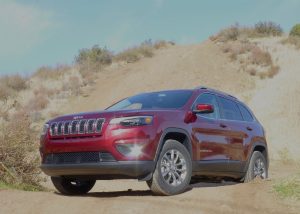
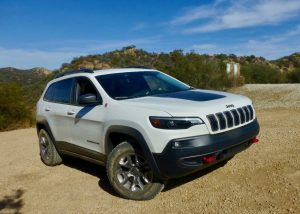
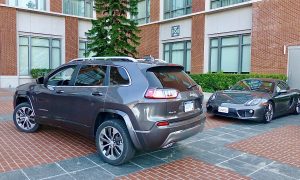
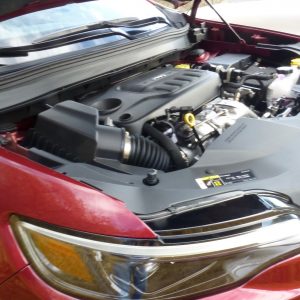
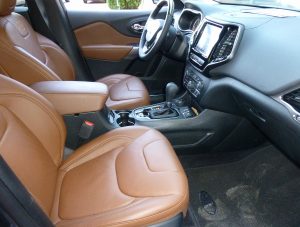
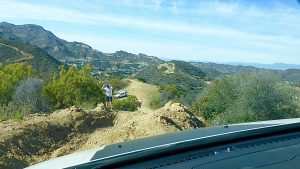
 John Gilbert is a lifetime Minnesotan and career journalist, specializing in cars and sports during and since spending 30 years at the Minneapolis Tribune, now the Star Tribune. More recently, he has continued translating the high-tech world of autos and sharing his passionate insights as a freelance writer/photographer/broadcaster. A member of the prestigious North American Car and Truck of the Year jury since 1993. John can be heard Monday-Friday from 9-11am on 610 KDAL(www.kdal610.com) on the "John Gilbert Show," and writes a column in the Duluth Reader.
John Gilbert is a lifetime Minnesotan and career journalist, specializing in cars and sports during and since spending 30 years at the Minneapolis Tribune, now the Star Tribune. More recently, he has continued translating the high-tech world of autos and sharing his passionate insights as a freelance writer/photographer/broadcaster. A member of the prestigious North American Car and Truck of the Year jury since 1993. John can be heard Monday-Friday from 9-11am on 610 KDAL(www.kdal610.com) on the "John Gilbert Show," and writes a column in the Duluth Reader.